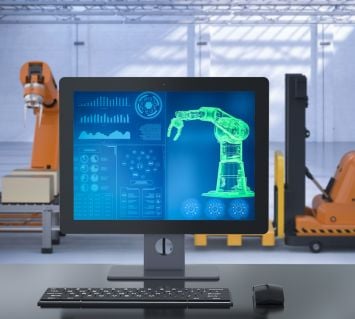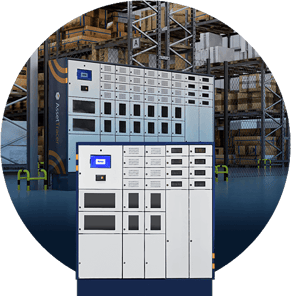By Jay Palter | October 11, 2023
Welcome to Industry 4.0, where manufacturing and production processes are transformed by a new generation of network technology, data-driven decision-making, and real-time optimization. This article explores this revolution's intricacies that have redefined how products are conceived, produced, and delivered to the world.
Industrial automation has long helped forward-thinking companies generate a competitive advantage. However, in the age of Industry 4.0, automation ceases to be merely a nice to have, it has become a necessity for every business striving to remain relevant.
In this rapidly expanding Industry 4.0 landscape, companies equipped with a comprehensive array of both traditional and cutting-edge digital smart manufacturing automation systems are primed for success. But what exactly is smart automation? And what exactly is Industry 4.0, for that matter?
What is Industry 4.0?
"Industry 4.0" is the nickname for the ongoing fourth industrial revolution (4IR), whose defining feature is the widespread adoption of intelligent automation systems and the utilization of Internet of Things (IoT) devices. In Industry 4.0, businesses are actively seeking ways to connect these automated systems to other infrastructure and integrate them with more business processes. The goal is to create data-driven feedback loops that allow businesses to enhance manufacturing and other operations throughout their organization.
What are the key components of Industry 4.0?
Networked, interconnected, seamless—these are all common descriptors of Industry 4.0 operations.
Convergence of physical and network systems
Industry 4.0 businesses thrive on the fusion of physical and network infrastructure. In tech circles, this is called “convergence.” Everything is connected in modern manufacturing. Physical infrastructure controls—and can be controlled by—digital systems. And vice versa.

Industrial automation
Industrial automation is one very specific type of convergence that is growing rapidly. The global market for industrial automation services is poised to expand from $171.23 billion in 2022 to $322.67 billion by 2030. These systems harness information technology, robotics, and integrated mechanical controls to transform manufacturing processes. The goal is to enhance efficiency and gain better control over product quality. Automation systems can be either stand-alone or integrated right into individual devices. Networked sensors play a crucial role in continuously monitoring system behavior and performance.

The Internet of Things (IoT)
IoT is currently the high point for business system connectivity, and fully IoT-integrated operations are what Industry 4.0 companies strive for. Industrial Internet of Things (IIoT) systems are manufacturing, operational, and administrative equipment networked to monitor and modify performance. The goal of deploying IoT systems is to enable them to communicate, share data, and take actions that optimize processes and enhance decision-making.

Real-time data collection
Data drives business, and real-time data collection and analysis are at the core of Industry 4.0. The days of individual, intuition-based decision-making are fading fast. Real-time data gives manufacturers a crystal-clear view of their operations, with less risk of human error or observer bias. Even experts can be deceived.
Whether adjusting production schedules, optimizing resource allocation, or predicting maintenance needs, data-driven decisions enhance efficiency and productivity. The beauty of real-time data is that it provides a feedback loop for continuous improvement. Manufacturers can analyze historical data to identify trends, inefficiencies, and areas for optimization, fostering a culture of ongoing improvement.

Smart factories
Imagine a manufacturing facility where machines communicate with each other, making real-time decisions to optimize production. Inventory is automatically replenished as needed, reducing carrying costs and stockouts. Equipment management systems keep equipment operating at peak efficiency, with maintenance performed just before necessary, preventing costly downtime. Security is comprehensive—meaning both physical security and network security, and data flows securely throughout the entire operation. That is a smart factory.
At the heart of smart factories lay all of the technologies described above:
- Are you looking to improve regulatory compliance?
- Are you trying to reduce costs?
- Are you trying to increase employee morale?
- Boost the productivity of remote workers?
These systems are different from the clunky, single-purpose devices of the past. Today's robotic and automation systems are agile and versatile and are designed to operate seamlessly alongside human workers, performing repetitive tasks with precision and efficiency. Automation eliminates errors, accelerates production, and ensures consistent quality.
Smart factories are more than just a concept; they represent the future of manufacturing. By embracing automation, data analytics, and cutting-edge technologies, these facilities epitomize the principles of Industry 4.0, driving efficiency, productivity, and competitiveness to new heights in the modern industrial landscape.
Key advantages of moving to Industry 4.0 now
Moving to Industry 4.0 operations isn't merely a technological upgrade. It requires a shift in thinking, business culture, and operations. But that doesn’t mean it needs to be complex.
Starting with a few key upgrades—such as smart manufacturing systems—can get a powerful snowball of change rolling. These asset management systems offer many important advantages for manufacturing businesses entering Industry 4.0.
Reduced operating costs
 Labor is expensive. Much repetitive, manual labor in manufacturing can be automated. In previous eras, that was usually mechanical operations. Now, much knowledge-based but still tedious work can be automated with the latest smart manufacturing technology. As these repetitive and labor-intensive tasks are automated, businesses can significantly reduce per-unit production costs.
Labor is expensive. Much repetitive, manual labor in manufacturing can be automated. In previous eras, that was usually mechanical operations. Now, much knowledge-based but still tedious work can be automated with the latest smart manufacturing technology. As these repetitive and labor-intensive tasks are automated, businesses can significantly reduce per-unit production costs.
Automation is not necessarily about reducing workforce sizes. It is about making the work employees do something only human beings can do. The scope of machine automation is greatly expanded in Industry 4.0.
Enhanced quality
 Smart industrial automation systems deliver consistent, error-free performance. Unlike human workers, they don't suffer from fatigue or get sick. They operate reliably and consistently, no matter the time of day. This translates into higher-quality output with reduced variations and defects in production. Safety checks and critical quality control measures are always noticed, ensuring each product meets the most stringent standards.
Smart industrial automation systems deliver consistent, error-free performance. Unlike human workers, they don't suffer from fatigue or get sick. They operate reliably and consistently, no matter the time of day. This translates into higher-quality output with reduced variations and defects in production. Safety checks and critical quality control measures are always noticed, ensuring each product meets the most stringent standards.
Increased efficiency
 Tracking key performance indicators (KPIs) enables you to improve your organization's performance continuously. Key asset maintenance KPIs, such as Mean Time Between Failures (MTBF) and Overall Equipment Effectiveness (OEE), provide daily performance insights for your physical assets.
Tracking key performance indicators (KPIs) enables you to improve your organization's performance continuously. Key asset maintenance KPIs, such as Mean Time Between Failures (MTBF) and Overall Equipment Effectiveness (OEE), provide daily performance insights for your physical assets.
Setting KPI benchmarks is an important form of goal-setting for businesses. Clear goals and actionable plans enhance your facility's overall effectiveness and efficiency.
Learn More: Everything You Need to Know About Physical Asset Tracking Systems
Better health and safety
 Preventive maintenance reduces costs, improves asset performance, and eliminates unplanned downtime. However, preventive maintenance schedules must be tailored to your facility's unique needs. The point of these programs is not necessarily to prevent equipment damage. They’re to prevent downtime. The first case is about technology. The latter is about overall business concerns.
Preventive maintenance reduces costs, improves asset performance, and eliminates unplanned downtime. However, preventive maintenance schedules must be tailored to your facility's unique needs. The point of these programs is not necessarily to prevent equipment damage. They’re to prevent downtime. The first case is about technology. The latter is about overall business concerns.
To create an effective preventive maintenance schedule, organize and analyze all available asset data, prioritize critical assets, and allocate maintenance funds accordingly. Continuously assess your preventive maintenance activities' performance, maintenance expenses, and effectiveness. Adjust your schedule as needed to decrease downtime further, improve asset performance, and extend asset lifespans.
Navigating the emerging trends of Industry 4.0
As manufacturing sector veterans might expect, the reality of Industry 4.0 is ever-evolving. It's crucial to understand the latest trends that are shaping the way leading companies operate and innovate. Here, we explore the latest trends in Industry 4.0 thinking and the specific technologies driving them forward.
Mature IoT technology is increasing the pace of convergence
One of the defining trends in Industry 4.0 is the convergence of Information Technology (IT) and Operational Technology (OT). These domains operated in relative isolation for most of the twentieth century with limited interaction. The advent of the Internet changed that. The latest generation of miniaturized, networked IoT sensors has increased the pace of convergence to new levels.
Automated decision-making
A hallmark of Industry 4.0 is the growing use of smart systems with the ability to make autonomous decisions. Machine learning and AI tools enable on-site systems to adapt and optimize performance without centralized control or human intervention. For example, a smart key locker can rotate fleet key sign-outs when a driver flags a maintenance issue in a particular vehicle.
This decentralization of decision-making has far-reaching implications. It reduces the burden on central supervisors to be involved in routine tasks. Additionally, the agility of smart systems enhances emergency response efforts, allowing them to trigger rapid, autonomous shutdowns when necessary. This minimizes risks and underscores the resilience of Industry 4.0 systems.
Transparency
Industry 4.0 introduces a new era of digital transparency through advanced data collection and analysis. Smart systems are now equipped to capture vast quantities of data, which can be processed and transformed into actionable business intelligence.
And again, the proliferation of small, wireless Internet of Things (IoT) devices is instrumental in this pursuit of transparency. These devices can be deployed in locations previously inaccessible to traditional wired automation systems, shedding light on manufacturing operations that were once entirely offline and inaccessible to data-driven decision-makers.
Worker enhancement
Digital systems excel at data processing and rapid analysis, but even in Industry 4.0, complex problem-solving and nuanced decision-making remain uniquely human domains. The goal of this new way of working is to make human work as human as possible. If tedious work can be automated, it should be.
Industry 4.0 analytics are designed to complement and augment human capabilities. They make human work more manageable and safer. By harnessing the power of technology to gather and process vast amounts of data in seconds, Industry 4.0 ensures that human minds can focus on what they do best: strategic thinking, creative problem-solving, and critical decisions.

Contact Real Time Networks today for expert advice on designing your Industry 4.0 smart management systems.
Subscribe to our blog

Jay Palter
Vice President of Marketing & Partnerships




